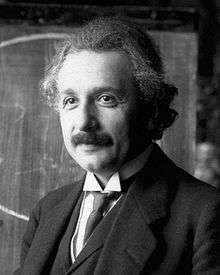Tea leaf paradox


.jpg)
The tea leaf paradox describes a phenomenon where tea leaves in a cup of tea migrate to the center and bottom of the cup after being stirred rather than being forced to the edges of the cup, as would be expected in a spiral centrifuge. The correct physical explanation of the paradox was for the first time given by James Thomson in 1857. He correctly connected the appearance of secondary flow (in both Earth atmosphere and tea cup) with ″friction on the bottom″ [2]. The formation of secondary flows in an annular channel was theoretically treated by Boussinesq as early as in 1868.[3] The migration of near-bottom particles in river-bend flows was experimentally investigated by A. Ya. Milovich in 1913.[1] The solution first came from Albert Einstein in a 1926 paper in which he explained the erosion of river banks, and repudiated Baer's law.[4][5]
Explanation
Stirring the liquid makes it spin around the cup. In order to maintain this curved path, a centripetal force in towards the center is needed (similar to the tension in a string when spinning a bucket over your head). This is accomplished by a pressure gradient outward (higher pressure outside than inside).
However, near the bottom and outer edges the liquid is slowed by the friction against the cup. There the fictitious (inertial) centrifugal force is weaker and cannot overcome the pressure gradient, so these pressure differences become more important for the water flow. This is called a boundary layer or more specifically an Ekman layer.[6]
The inertial centrifugal force due to the bulk rotation of the liquid results in the development of an outward pressure gradient within the liquid, where the pressure is higher along the rim than in the middle. This manifests itself as the formation of a concave liquid-air interface. This pressure gradient provides the necessary centripetal forces for circular motion when summed over the entirety of the rotating liquid.
However, within the boundary layers where fluid rotation is slowed by friction and viscous effects, the centripetal force due to pressure gradient is dominant over the inertial forces from rotation, and creates an inward secondary flow within the boundary layer. The flow converges at the bottom of the teacup (where the tea leaves are observed to gather) and flows upwards to the surface. Higher up, the liquid flow meets the surface and flows outwards. The leaves are too heavy to lift upwards and remain in the middle. Combined with the primary rotational flow, the leaves will be observed to spiral inwards along the bottom of the teacup.[5]
Applications
The phenomenon has been used to develop a new technique to separate red blood cells from blood plasma,[7][8] to understand atmospheric pressure systems,[9] and in the process of brewing beer to separate out coagulated trub in the whirlpool.[10]
See also
References
- 1 2 His results are cited in: Joukovsky N.E. (1914). "On the motion of water at a turn of a river". Matematicheskii Sbornik. 28. Reprinted in: Collected works. 4. Moscow; Leningrad. 1937. pp. 193–216, 231–233 (abstract in English).
- ↑ James Thomson, On the grand currents of atmospheric circulation (1857). Collected Papers in Physics and Engineering, Cambridge Univ., 1912, 144-148 djvu file
- ↑ Boussinesq J. (1868). "Mémoire sur l'influence des frottements dans les mouvements réguliers des fluides" (PDF). Journal de mathématiques pures et appliquées 2 e série. 13: 377–424.
- ↑ Bowker, Kent A. (1988). "Albert Einstein and Meandering Rivers". Earth Science History. 1 (1). Retrieved 2008-12-28.
- 1 2 Einstein, Albert (March 1926). "Die Ursache der Mäanderbildung der Flußläufe und des sogenannten Baerschen Gesetzes". Die Naturwissenschaften. Berlin / Heidelberg: Springer. 14 (11): 223–4. Bibcode:1926NW.....14..223E. doi:10.1007/BF01510300. English translation: The Cause of the Formation of Meanders in the Courses of Rivers and of the So-Called Baer’s Law, accessed 2017-12-12.
- ↑ "CEE 262A Hydrodynamics Lecture 18" (PPT). 2007. p. 35. Retrieved 2008-12-29.
- ↑ Arifin, Dian R.; Leslie Y Yeo; James R. Friend (20 December 2006). "Microfluidic blood plasma separation via bulk electrohydrodynamic flows". Biomicrofluidics. American Institute of Physics. 1 (1): 014103 (CID). doi:10.1063/1.2409629. PMC 2709949. PMID 19693352. Archived from the original on 9 December 2012. Retrieved 2008-12-28. Lay summary – Science Daily (January 17, 2007).
- ↑ Pincock, Stephen (17 January 2007). "Einstein's tea-leaves inspire new gadget". ABC Online. Retrieved 2008-12-28.
- ↑ Tandon, Amit; Marshall, John. "Einstein's Tea Leaves and Pressure Systems in the Atmosphere" (PDF). Retrieved 2008-12-29.
- ↑ Bamforth, Charles W. (2003). Beer: tap into the art and science of brewing (2nd ed.). Oxford University Press. p. 56. ISBN 978-0-19-515479-5.
External links
- Highfield, Roger (14 January 2008). "Dr Roger's Home Experiments". The Daily Telegraph. Retrieved 2008-12-28.
- Sethi, Ricky J. (September 30, 1997). "Why do particles move towards the center of the cup instead of outer rim?". MadSci Network. Retrieved 2008-12-29.
- Booker, John R. "Student Notes - Physics of Fluids - ESS 514/414" (PDF). Department of Earth and Space Sciences, University of Washington. ch. 5.8 p. 48. Retrieved 2008-12-29. See also figure 25 in figures.pdf
- Stubley, Gordon D. (May 31, 2001). "Mysteries of Engineering Fluid Mechanics" (PDF). Mechanical Engineering Department, University of Waterloo. Archived from the original (PDF) on February 6, 2009. Retrieved 2008-12-29.
- Einstein's 1926 article online and analyzed on BibNum (click 'Télécharger' for English).